Ladakh or Ladvags, meaning ‘The Land of High Passes’, has a rich and diverse history. The history of Ladakh can be divided into three periods: the ancient period (till 10th century AD), the medieval period (10th century-19th century) and the modern period (19th century-till date).
Ancient History of Ladakh (up till 10th century AD)
Colonization of Ladakh by Mons and Dards
The first groups of people to settle in Ladakh were Mons and Dards. The Mons migrated from present day Himachal Pradesh while the Dards came from present day Gilgit. Both these people were Aryans by race. The present day Gya-Meru area was the first to be settled.
The Influx of Mongols
The Mongols came from Tibet as nomads and gradually overpowered the Mons and Dards.
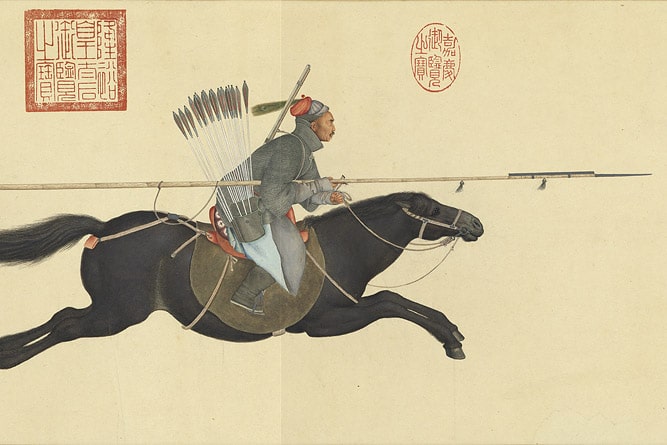
Mongol soldier
The Struggle for Ladakh
Ladakh bore witness to the struggle between the Tibetan Empire and the Tang Empire of China. Tibetan forces briefly subdued the natives for brief periods of time during 7th and 8th centuries.
The Age of the Chos (Princes)
Ladakh was divided into several small principalities, each ruled by a Cho or a prince. Upper Ladakh was ruled by the Cho of Gya and Lower Ladakh was ruled by Cho Bagdar Skyabs. Somewhere around the beginning of 10th century, an army from present day Xinjiang invaded Ladakh. The Cho of Gya asked the ruler of Ngaris, Skyid-Lde Nyimagon for assistance.
Medieval History of Ladakh
The First Kings (10th -11th century)
The first King of Ladakh was the ruler of Western Tibetan province of Ngaris Skor Soom, Skyid Lde Nyima Gon who was a direct descendent of Tibetan emperors and one of the two claimants to the Tibetan throne. He divided his domains between his three sons. The eldest son, Pal Gyi Gon received Ladakh, with its capital at Shey, the second son, Tashi Gon received Ngaris, and the third son, Detsug Gon received Zangskar and Spiti.
The First Conquests (1080-1110)
Lhachen Utpala, who most probably reigned from 1080-1110, conquered present day Kullu and forced it to pay a tribute and for a time being Ladakh became the paramount power in the Western Himalayas.
The Great Darkness (12th century)
The Chronicles of Ladakh, written in 17th century, leaves a huge gap during the 12th century. Recent research shows that Ladakh was ruled by the Brokpas during this period.
The Adventurer Prince
Crown Prince Rinchen Shah, son of King Lhachen Gyalpo, went to Srinagar, Kashmir and played an active part in the power struggle there. He converted to Islam and reigned as the first Muslim king of Kashmir from 1320-1323.
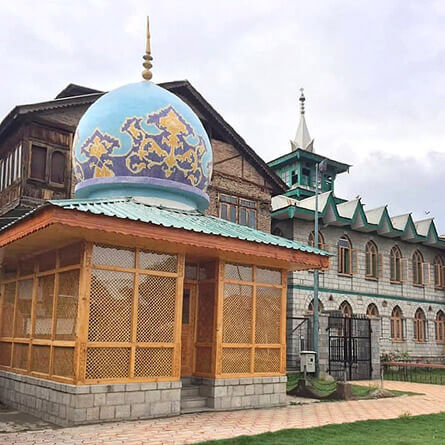
The tomb of Rinchen Shah located in Srinagar
The Era of Two Kingdoms (1400-1440)
Tagspa Bum Lde became the King of Upper Ladakh while his younger brother, Tagspa Bum, became the King of Lower Ladakh. Tagspa Bum Lde outlawed animal slaughter and build the Chamba (Maitreya) Temple in Leh while Tagspa Bum build the Fortress of Tigmosgang.
A Time of Invasions (1440-1550)
The period between mid-15th century to mid-16th century is mired in darkness. The official history of Ladakh, The Chronicles of Ladakh, tend to gloss over the failures of the Kings and is riddled with inaccurate dating. But what we can gather from contemporary sources is that Ladakh was invaded repeatedly during this period. The Kashmiris under Sultan Zain-ul-Abidin invaded in the mid-15th century. After that the Uighurs under Mirza Haider repeatedly invaded Ladakh in the first half of 16th century.
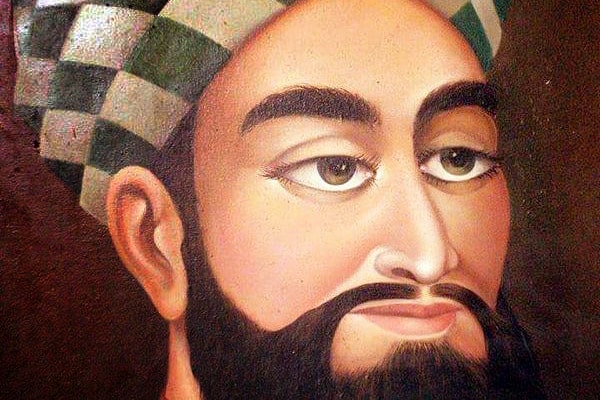
Sultan Zain-ul-Abidin of Kashmir invaded Ladakh in the mid-15th century
The Founding of the Namgyal Dynasty
In the midst of all this turmoil, the Namgyal Dynasty was founded with its capital at Basgo. This dynasty united both the Upper and Lower Ladakh under one kingdom. It conquered Zangskar and beat back a series of invasions from Kashmir and Kashgar.
The Kingdom at its Greatest Extent (1575-1595)
The Kingdom of Ladakh was at its greatest extent under King Tsewang Namgyal. According to The Chronicles of Ladakh, his rule extended from Gilgit in west to Namrims in the east. He even planned to invade present day Xinjiang. But decided against it, when the people of Nubra pleaded with him to not to attack as it would damage the trade between them and Xinjiang.
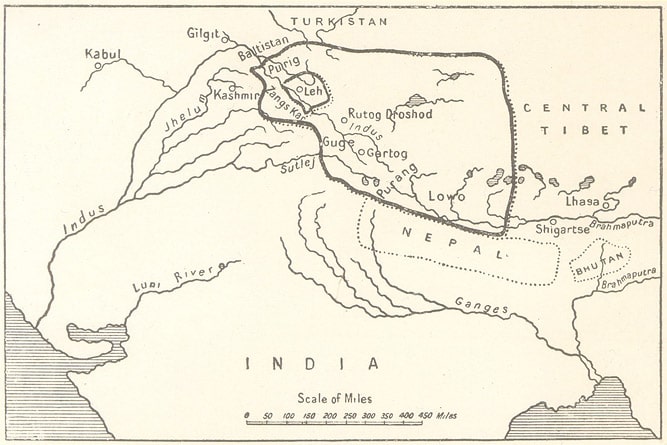
The Kingdom of Ladakh at its greatest extent under King Tsewang Namgyal
An Empire Lost (1595-1616)
Jamyang Namgyal came to the throne after his brother, Tsewang Namgyal. Areas under Ladakhi rule rose in revolt. To reestablish Ladakhi rule, Jamyang Namgyal invaded Baltistan. He moved up the Losar (New Year) celebrations by 2 months. The Cho (Prince) of Skardo, Ali Mir had united the various principalities of Baltistan under his rule. He defeated the Ladakhi forces and captured the king.
A Glorious Renaissance (1616-1675)
Jamyang Namgyal’s son, Sengge Namgyal, came to the throne in 1616. By 1630, he had completed the conquest of Ngaris Skorsoom (Western Tibet) and marched with his army till Siri Karmo in Central Tibet where he fought the Tibetan forces to a standstill. He built the nine storey Leh Palace, the tallest structure in the Himalayas at the time. He also built the Hemis monastery. He took Staktsang Raspa as his religious teacher. He was, however, defeated by a combined force of Baltis and Mughals at Bod Kharbu in 1639. But he repulsed a Mongol invasion of Guge. He died on his way back from the war in 1642 at Hanley. His son, Deldan Namgyal acceded to the throne. Under him, Ladakhi forces, under Kalon Bangkapa Shakya Gyatso, took control of Purig in Western Ladakh and managed to pacify the Chos (Princes) of Baltistan. He also built the Shey Palace, with its gilded copper statue of Lord Buddha, and the Rudok Palace in Western Tibet.
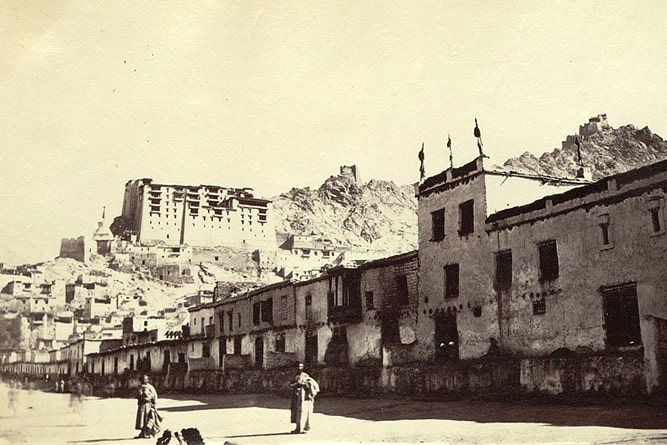
Leh Bazar and Leh Palace built by Sengge Namgyal, photo taken in 1873
The Ladakhi-Tibeto-Mongol War and its Aftermath (1679-1684)
In 1679, Tibeto-Mongol forces under the command of a Mongol prince, Galdan Tsewang, invaded Ladakh. The Ladakhi forces were commanded by Kalon Bangkapa Shakya Gyatso. The two forces clashed in Western Tibet and the Ladakhis were forced back. The two forces again clashed near Chang La. The Ladakhi forces retreated to the fortresses of Basgo and Tigmosgang. The enemy forces captured Leh and besieged the Basgo fortress without success for 3 years. Finally, the Ladakhis asked the Mughals for help. They agreed to help on one condition that the King would convert to Islam and build a mosque in Leh. Once the Ladakhis agreed to the offer, help was sent from Kashmir. The combined Ladakhi and Mughal forces clashed with the Tibeto-Mongol forces near Basgo. The enemy forces were defeated. They again clashed near Spituk and the Tibeto-Mongol forces were pursued till Tashigang in present day Ngaris, where they barricaded themselves in a fort. In the ensuing peace treaty, signed at Tigmosgang, Ladakh lost the Ngaris Skorsoom region to the 5th Dalai Lama. And the Pashmina wool trade became the exclusive domain of Kashmiri traders.
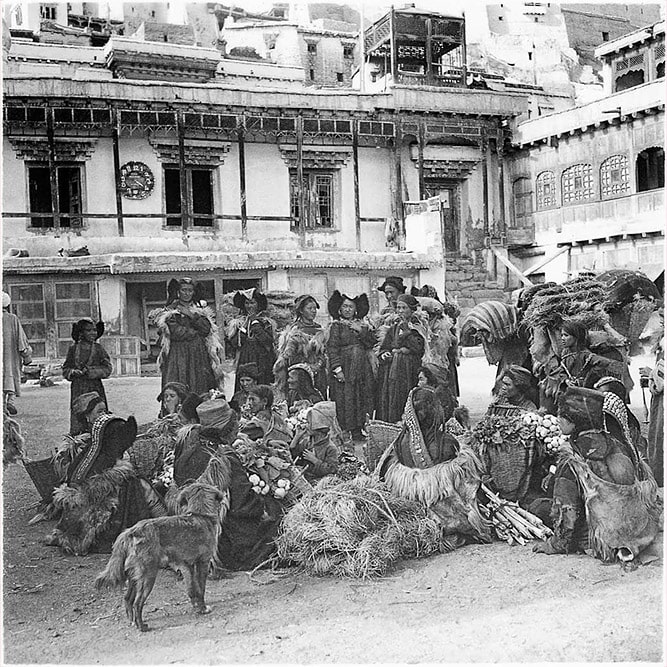
Group of women in front of the Jama Masjid mosque in Leh built in the 17th century, photo taken in 1934
A Shrunken Patrimony (1695-1729)
Lhachen Nyima Namgyal came to the throne in 1695. He was adopted by the Khri Sultan as his heir and on the death of Khri Sultan, he acquired his domains which comprised most of Western Ladakh. He married Zizi Khatun, the daughter of the Cho of Khapulu, after his first wife, Saskyong Wangmo passed away. This obliged the Ladakhis to get involved in Balti politics. Ladakh sent military expeditions into Baltistan throughout the 18th century with great success.
An Age of Insignificant Kings and Powerful Nobles (1729-1800)
Deskyong Namgyal succeeded his father, Nyima Namgyal, who abdicated in 1729. Deskyong Namgyal, first, married Nyilza Wangmo, a princess of Mustang. They had a son, Saskyong Namgyal and a baby prince who was later recognized as the reincarnation of Panchen Lama, the second most powerful figure in Tibet. But before the recognition of the boy, the couple divorced. He then married Kunzoms who gave birth to a son, Tsewang Namgyal. His third wife was Putit Wangmo of Deskit in Nubra. She gave birth to a son, Phuntsog Namgyal. A dispute arose between Nyima Namgyal and Deskyong Namgyal over the marriage of Princess Tashi Wangmo to the King of Kishtawar. Soon after, Prince Tashi Namgyal, actively backed by the Queen Mother, was given Purig with its capital at Mulbeek as a separate kingdom much to the consternation of the nobles. Nyima Namgyal died at Mulbeek in 1738. Deskyong Namgyal died a few months later in 1739. His eldest son, Saskyong Namgyal had ordained as a monk at the Hemis Monastery. Likewise, his second son had been recognized as the reincarnation of Panchen Lama. His third son, Tsewang Namgyal, was the heir apparent. However, his stepmother, Queen Putit Wangmo, proved too powerful. She ruled Ladakh briefly and was succeeded by her son, Phuntsog Namgyal. By this time, the Kalon of Stog, had acquired vast amount of royal lands by unlawful means. When the king decided to act against him, he took refuge in Mulbeek. Compounding the problem was the decision to levy custom duties on Kashmiri traders by King Tashi Namgyal of Purig. This greatly damaged the trade relations between Kashmir and Ladakh.
The Hanley Council of 1761
There was growing discontent within the aristocracy regarding the division of the kingdom and the unlawful succession of Putit Wangmo and her son, Phuntsog Namgyal, to the throne. Matters came to a head between Tashi Namgyal and Phuntsog Namgyal. Both sent envoys to the Dalai Lama requesting mediation. Accordingly, the Dalai Lama sent Kathog Rigzin to Ladakh. He convened a council at Hanley in 1761 where all the disputed parties and the aristocracy gathered. The following points were agreed upon: Tsewang Namgyal was to succeed to the throne and Phuntsog Namgyal was to be deposed. Tashi Namgyal would continue to rule Purig till his death after which it would revert back to the King of Ladakh. Amnesty was granted to the Kalon of Stog. It was also agreed upon that only the eldest son would succeed to the throne while the younger ones would enter the clergy.
The ‘Unkingly’ King
Tsewang Namgyal II, came to the throne in 1761. He married a princess of the Royal House of Zangla. Sometime later, he married a woman belonging to a low caste family from Kartse. The Queen felt insulted and went back to Zangla. This was against the customs of the time. It was certainly against the aristocratic norms if not the royal norms. The entire aristocracy rose up. The nobles barged into the Palace and beheaded the woman and took out a procession with the head of the King’s new wife mounted on a spear. He then married the daughter of Cho of Sod, who gave him 2 sons: Tsetan Namgyal and Tsepel Tondup Namgyal.
The Fledgling Hope of the Kingdom
Tsetan Namgyal succeeded his father as king. He was known for being a wise ruler and for his martial prowess. But he died at a young age due to a fall from horse.
The Last King (1820-1834)
Tsepel Tondup Namgyal succeeded his brother as king in 1820. His Prime Minister was Basgo Kalon Tsewang Tondup. The king built the Stog Palace (or Stok Palace), the present day residence of the Royal family. Tsewang Tondup proved to be an able administrator. He was however ousted from the office and soon died thereafter. The effect of his removal soon became apparent and led to the invasion by the Dogras.
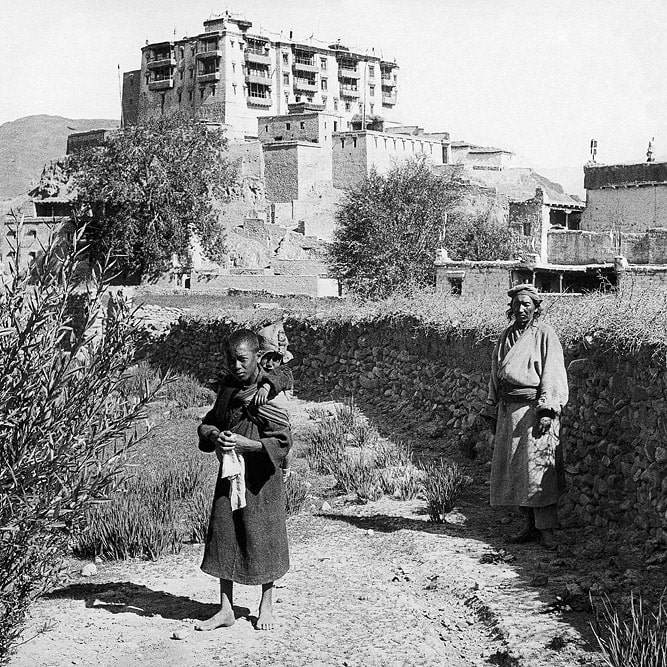
Stok Palace built by Tsepel Tondup Namgyal
Ladakh and the Silk Road
Ladakh lay at the junction of several routes, to its east was Tibet, to its west was Kashmir, to its north lay Xinjiang and to its south, the Mainland India. It occupies a strategic location on the Silk Road network of trading routes. The trade was what attracted the Dogra invasion. The revenue from it greatly contributed to the wealth of the Kingdom since time immemorial. Ladakh exported grains to Western Tibet. From Xinjiang, came textile and fine breed horses which was fashionable among the Ladakhi nobility. From Tibet, came pashmina, shahtoosh (Antelope wool), fur and the rare musk pods which were also found in Ladakh. From the south, came cotton and spices.
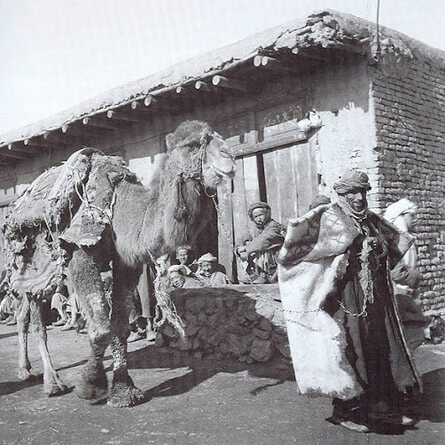
Caravan along the Silk Road
Modern History of Ladakh
The Dogra Invasion (1834-1835)
Gulab Singh, a vassal of Sikh King, Maharaja Ranjit Singh, sent a force of 5000 men under the command of Zorawar Singh, Wazir (Governor) of Kishtawar, to conquer Ladakh. The Ladakhi forces were led by Kalon of Stok, Dorjey Namgyal and the second-in-command was the Lonpo of Leh, Morup Stanzin. The forces clashed at Langkartse. In between, the Dogras agreed to withdraw if the Ladakhis pay a nominal tribute. The commanders agreed but the Queen disagreed. After a week of fierce fighting, Kalon Dorjey Namgyal was mortally wounded. Shortly, thereafter, an injured Morup Stanzin surrendered. Mulbeek Kalon Rtadin with a force of 200 men ambushed the Dogras and killed around 60 men including some of Zorawar’s top lieutenants. A bullet narrowly missed Zorawar, hitting his palanquin. By then, Kalon Bangkapa Morup Stanzin had raised a force of 2000 men and rallied the retreating Ladakhi forces. In the winter of 1834-35, he outflanked the Dogras and wiped out their garrison in Kargil. The Dogras retreated but the Ladakhis failed to take advantage of this success. The following year, the Ladakhis were soundly defeated. And the Dogras took Leh. They left after levying a tribute and war indemnity and appointing a representative.
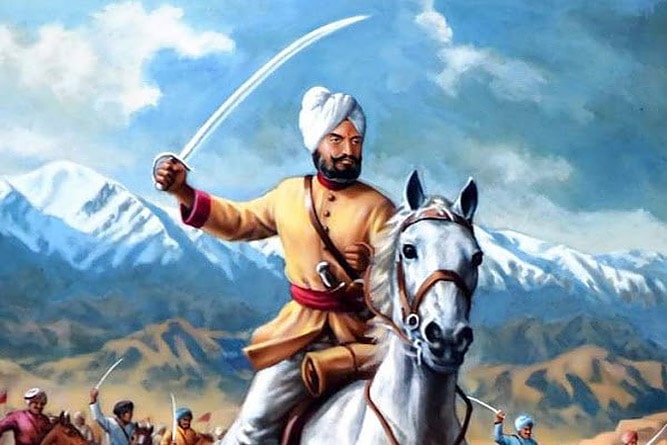
Zorawar Singh, a general of the Sikh Empire
Rebellions Galore (1835-1838)
As soon as the Dogras left, Zangskar rose in rebellion. Barely had the Dogras suppressed it, the entire kingdom rose up in arms. The Dogras quickly suppressed it. The King, Tsepel Tondup Namgyal, was deposed and Leh Lonpo Ngorup Stanzin was made the ruler while the Crown Prince Tsewang Rabstan fled to Shimla. Another rebellion broke out in Western Ladakh after which the Dogras removed the Leh Lonpo from power. The old king was reinstated but the real power lay in the hands of Kalon Bangkapa and Basgo Kalon.
The Tibetan Expedition and its Aftermath (1842-1843)
In 1842, Zorawar Singh led an expedition to conquer Ngaris. But his forces were decimated by a Tibetan force. As news of it reached Ladakh, a final uprising, supported by the Tibetans, against the Dogras. The heir-apparent to the throne, Jigmet Singey Namgyal, was crowned as the King of Ladakh. A Dogra army came to the rescue of the besieged garrison in Leh. The Ladakhi forces, on the arrival of the fresh Dogra forces, melted away. The Tibetans were defeated near present day Tangtse and a treaty was signed which ended the conflict.
Ladakh under the Dogras (1843-1947)
The Dogras appointed Wazirs or governors to look after the day to day administration of Ladakh Wazarat (province) which also included Baltistan. Trade flourished as before. A British official called Ladakh the Suez Canal of Central Asia and Leh, the Port Said of Central Asia. The Dogras kept the old aristocracy intact, merely giving them new titles and responsibilities.
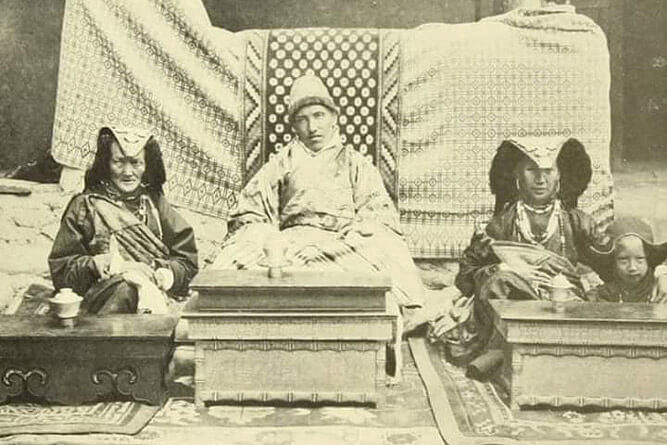
King Jigmet Dadul Namgyal (centre), the Queen Mother of Ladakh (left) and Queen Nyilza Wangmo (right)
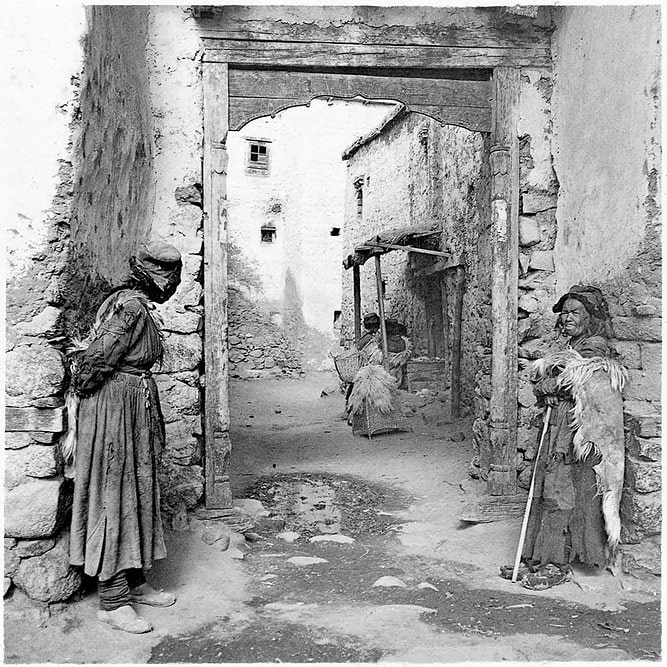
Leh Old Town in 1934
Emergence of Mercantile Families
Several mercantile families emerged in Ladakh during the Dogra period. Prominent among them were the Kalon family of Changspa, Srangar of Leh and the Radhu family of Leh, also known as Khwajagon.
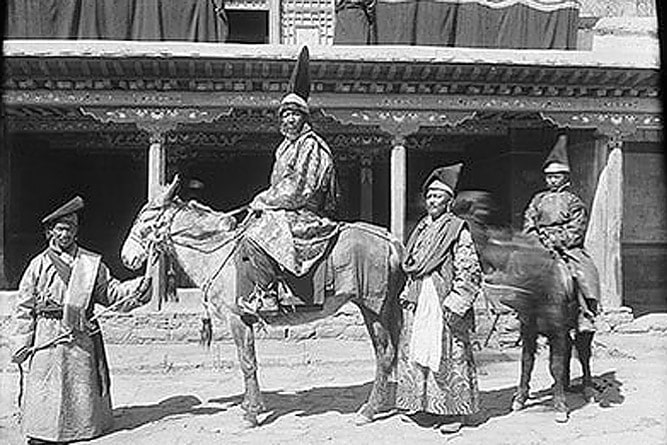
Dawa Shah Srangar (on horseback), leader of the Lopchak Mission to Tibet
Gyalsras Bakula Rinpoche (1918-2003): The Architect of Modern Ladakh
Kushok Bakula Rinpoche was born on 25th May, 1918 into the Matho branch of the Royal House of Ladakh. At a young age, he was recognized as the 19th incarnation of Arhat Bakula, one of the 16 direct disciples of Lord Buddha.
In 1926, he left for Tibet to pursue higher studies. He enrolled at the Draspung Loseling Monastic University. The 13th Dalai Lama appointed Geshes Lobzang Jungnes as his tutor. In 1940, during the Lhasa Monlams Chhenmo or the Great Prayer Festival of Lhasa, he achieved the first rank or the Geshes Lharampa Degree, the first Ladakhi to do so. He soon returned to Ladakh, where seeing the plight of the people, decided to stay back. In the post-independence era, he emerged as Ladakh’s tallest leader.
He facilitated the education of the masses and raised the issue of the need for all round development of the region at every forum. His role in uplifting the people of Ladakh from dire straits earned him the sobriquet of ‘The Architect of Modern Ladakh’. He was a member of the Constituent Assembly of Jammu and Kashmir. He was elected member of the Jammu and Kashmir Legislative Assembly from 1952-1967 and represented Ladakh in the Lok Sabha, the Lower House of Indian Parliament, from 1967-1977. Thereafter, he was appointed member of the Minorities Commission. In 1989, he was appointed as India’s ambassador to Mongolia. There he was instrumental in reviving Buddhism which earned him the title of Elchin Bagsha or the Ambassador Teacher. He was awarded Padma Bhushan, India’s third highest civilian award, in 1989 for his contribution to the society. In 2001, he was awarded Polar Star by the Mongolian Government for his efforts in reviving Buddhism in the country. He died on 4th November, 2003 in New Delhi. The then Prime Minister of India, Atal Bihari Vajpayee, in his condolence message, wrote, “It is hard to imagine Ladakh without Bakulaji”. He, indeed, was the face of Ladakh for more than 5 decades.
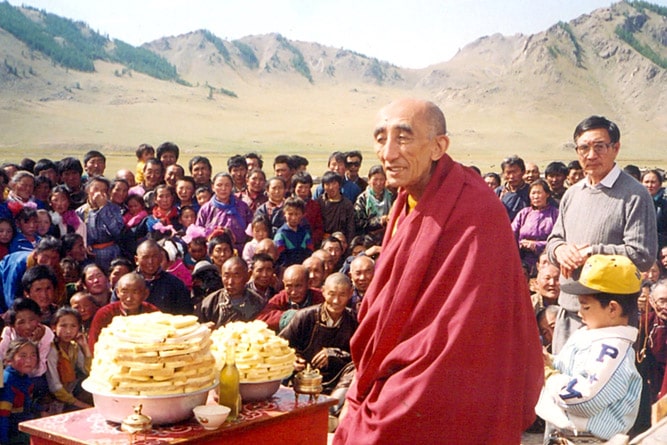
Kushok Bakula Rinpoche in Mongolia
The Pakistani Invasion and Incorporation into Indian Union (1947-1948)
When the Partition of the Indian subcontinent took place in 1947, the princely states were given 3 choices: to join the Indian union or Pakistan or to remain independent. Hari Singh, ruler of Jammu and Kashmir chose the 3rd option. Tribal raiders backed by Pakistan invaded the state. In desperation, Hari Singh asked for Indian assistance and subsequently, acceded to India. The tribal raiders came within 10 miles of Leh town where a local militia force held out long enough for the Indian forces to come to the rescue. A hastily constructed airstrip hastened their arrival. Before the referral of the matter to the United Nations, Ladakh proper was cleared of these tribals.
Emergence of Kushok Bakula and the Beginning of the Movement for Union Territory (1949-1957)
In post-independence Ladakh, Kushok Gyalsras Bakula Rinpoche, a direct descendent of the last independent king of Ladakh, emerged as the de facto leader of Ladakh. Right from the outset, Ladakh was neglected by the government based in Srinagar. Bakula Rinpoche vehemently opposed this attitude in his 1952 speech in the State Legislative Assembly and drew the attention of the world to the plight of the Ladakhis. In fact, right from its incorporation into the Indian Union, Ladakhis had been demanding separation from Jammu and Kashmir.
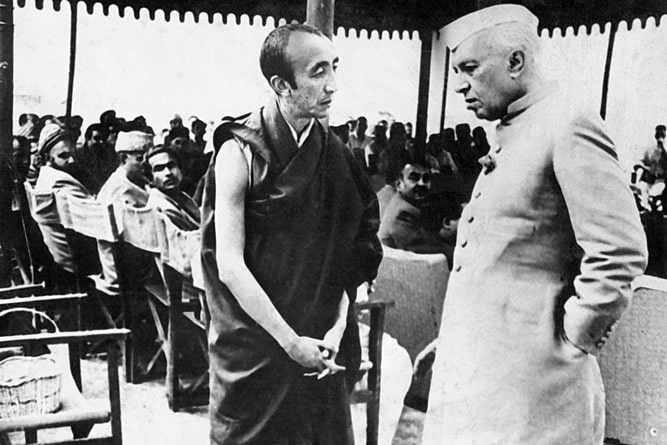
Kushok Bakula Rinpoche with the first prime minister of independent India, Jawaharlal Nehru, during a meeting in Srinagar in 1953
The Political Factions of Modern Ladakh (1957-1980)
In 1957, Tsering Phuntsog of Shunu stood in the election against Kushok Bakula Rinpoche and a breakaway faction called Congress B emerged. Bakula Rinpoche’s supporters formed Congress A with the focal point of its activities being the Leh Khangsar Mansion.
Indo-Chinese War (1962)
In 1949, Communist China occupied Tibet and in 1959, after a failed rebellion against the Chinese occupation, the Dalai Lama and thousands of Tibetan refugees fled their country and the Indian Government gave them asylum. A Tibetan Government in exile was established in Dharamshala in Himachal Pradesh. In 1956-1957, China constructed a road through the Aksai Chin region which was disputed since 19th century. India adopted a Forward policy in 1960 by which it constructed posts on its border with China to deter Chinese designs. In 1962, China went on the offensive, capturing Indian territories in Ladakh and in the North East, including Aksai Chin region in North Eastern Ladakh. The Chinese offensive met with fierce resistance in Ladakh but in the East, it managed to occupy the entire present day Arunachal Pradesh. The conflict lasted from 20th October, 1962 to 21st November, 1962.
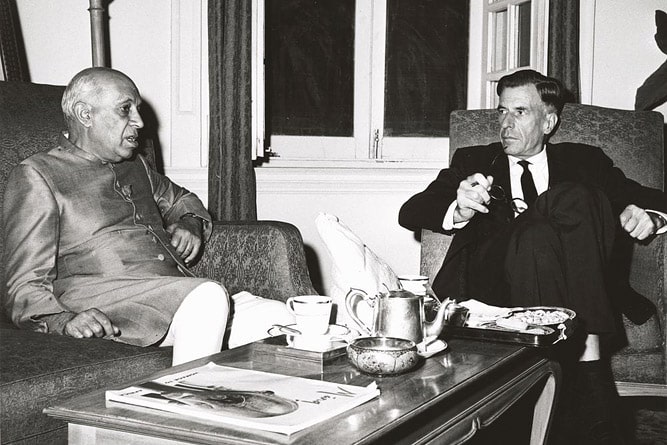
U.S. Ambassador to India John Kenneth Galbraith and Prime Minister Nehru conferring at the time of the conflict
Opening of Ladakh to tourism (1974)
In 1974, Indian Government opened Ladakh for tourists, initiating a process that has since then completely transformed the socio-cultural and economic life of the region. It has given a tremendous fillip to the economy of Ladakh as the number of tourists coming to the region has grown exponentially, evidently attracted by its rich cultural heritage and traditions and of course, it's splendid natural beauty.
Movie shot by Ed van der Kooy who visited Ladakh in 1978
The Political Agitation of 1989
In 1988, Thupstan Chhewang became the President of Ladakh Buddhist Association (LBA) while, Nawang Rigzin Jora became the General Secretary. Religious clashes broke out in 1989 and the LBA launched an agitation demanding complete separation from Kashmir. The entire region came out onto the streets demanding political autonomy.
The Formation of Hill Councils and the first councils (1996-2005)
After hectic negotiations, the Indian Government agreed to grant both the districts of Ladakh Autonomous Hill Councils on the model of the one granted to the Gurkhas. Only Leh accepted the offer. Elections were held for the Council and the Indian National Congress swept to power. Thupstan Chhewang became the first Chief Executive Councillor. The State Government refused to grant the Council any real powers. Only in 2002, with the change in power of the State Government, were some powers given. Nevertheless, it became a significant element in Ladakhi politics. Thupstan Chhewang remained at its helm for two terms.
The Kargil Conflict (1999)
In early 1999, as the Lahore Summit was taking place between India and Pakistan, Pakistani troops occupied vacant Indian military posts in the area around Kargil with an aim to cut-off Ladakh from Kashmir and force Indian military from the Siachen glacier and ultimately force India to negotiate on the Kashmir issue. Local shepherds alerted the Indian troops to the presence of Pakistani troops. Ground patrols and aerial reconnaissance revealed the full extent of the intrusion. India launched Operation Vijay to clear out the intruders and mobilized troops on a large scale in the Kargil sector. India brought in its Air Force and artillery to take out the Pakistani positions and support the advance of its infantry. Despite stiff resistance, Indian troops regained the peaks hitherto occupied by the enemy. As the situation became untenable for Pakistan, both militarily as well as diplomatically, Pakistani Prime Minister Nawaz Sharif flew to Washington DC, where he agreed, after meeting with US President Bill Clinton, to withdraw troops from across the Line of Control, the border between India and Pakistan. By the end of July, the conflict was officially over.
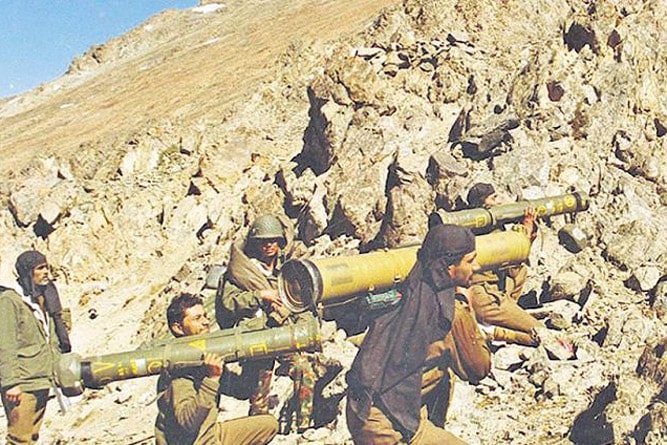
Indian troops during the Kargil conflict
Emergence and the Fall of LUTF (2002-2010)
In 2002, Ladakh, Leh district in particular, witnessed the dissolution of political parties and the coming together of politicians under one banner. The Ladakh Union Territory Front was formed. Its main objective was to obtain Union Territory status for Ladakh. In 2004, Thupstan Chhewang contested the General Elections as its candidate. He won by a record margin. In 2005, a breakaway faction of the LUTF joined the Indian National Congress and contested the Council Elections, which it lost badly. Nevertheless, in the Assembly Elections of 2008, Nawang Rigzin Jora contesting on the Congress ticket defeated Thupstan Chhewang, the LUTF candidate. In 2010, the remaining members of the party led by Thupstan Chhewang joined the Bhartiya Janta Party.
Creation of the Union Territory of Ladakh (2019)
On 5th August, 2019, the Indian Parliament abolished the Article 370 of Indian Constitution, which gave special status to Jammu and Kashmir, and reconstituted the state into two Union Territories: Jammu and Kashmir Union Territory and Ladakh Union Territory.
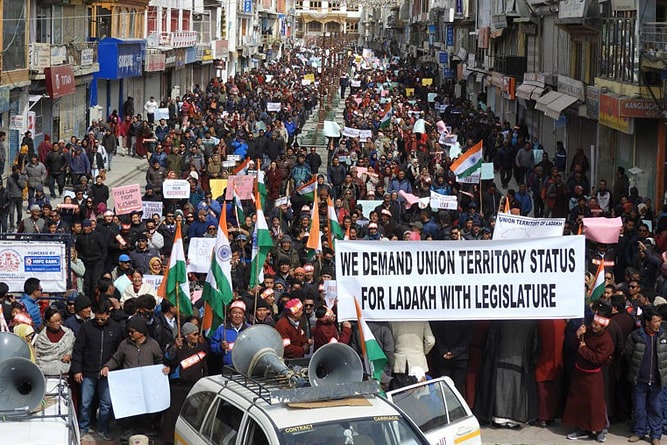
Rally demanding Union Territory for Ladakh held in Leh in March 2019
